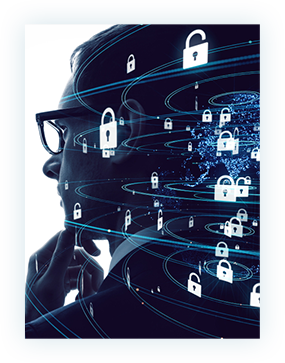Building a Smart Council in the Evolving Digital World
In our last blog, we examined how external pressures forced local councils to modernise their legacy systems and how lagged tech adoption can dramatically impact employee retention and resident well-being.
While this digitisation is necessary, it also left many wondering how far to take it.
How much of a council digital transformation is required before a council can be considered ‘smart’?
A flashy website might be great, but without security, data management, and a council cloud, it’s nothing more than a smokescreen offering no real benefit to citizens and key stakeholders. At the other end of the spectrum and looking to the future, you have the prospect of hugely integrated systems and modernised tech, everything from facial recognition to autonomous drones.
We thought we’d take a look at what it means to be a smart council in the ever-changing digital landscape, what some councils are doing to meet these changes head on, and tips for councils to overcome common roadblocks.
The Three Stages of ‘Smart Council’
With the expansion of new technology and the explosion of AI programs such as ChatGPT, it is not surprising that modernising local government to keep up with the rapidly evolving digital world might seem like a bit of a pipe dream. Is the concept of a smart council is a purely aspirational or a viable possibility? Well, first maybe we need to establish exactly what is a smart council.
Defining a smart council isn’t easy when everyone has a different view of what it is. However, a smart council is best understood within the context of its transition. Let’s examine a council digital transformation in three stages and how each stage might deal with a common issue in regional local councils.
- Pre-Adoption with No Cloud Migration
A council with no cloud support that relies on legacy systems, at the very worst, having heavy reliance on something like Excel spreadsheets couldn’t be considered a smart council. This is because they cannot provide adequate digital services, have no way to leverage data insights, and rely on clunky communication channels.
For example. in the case of asset management, something like the reporting of dumped rubbish is common. A resident without a digital online service, would have to ring the council to flag the issue and likely be put on hold; then, the council would prepare the work order through email or phone, assign it, and dispatch the team. The team, once out on the site of the waste, will maybe fill in a paper form, or send another email – someone must then manually enter in further information to close the loop and report that the job has been dealt with.
- Data, Cloud and Platform Integrated
A local council with a more robust council digital strategy that includes, cloud adoption and a data-connected ecosystem will likely be considered a smart council.
In our example of dumped rubbish, a council at this stage can create a platform that allows users (citizens) to upload an image or report the incident through an online channel. The gap between services may then come in dispatching the council worker to site, and reporting the job outcome. Are all the lines of communication linked, is the data automated and able to integrate into backend systems? In most cases, where a council has a considered digital strategy that takes advantage of cloud and connected systems, then the answer is yes. And that council is on their way to being a smart council. They have all the capabilities there to have an end-to-end digital environment.
- Fully Integrated Council with Cutting Edge Predictive Systems, IoT, and AI
But there is another stage in smart councils. Although more futuristic, larger metropolitan councils are integrating large-scale automated processes. Whether it’s covert cameras that detect drivers on their phones and issue fines or using predictive technologies to forecast demands from social media sentiment for services such as waste management, public transportation, and emergency response, change is coming.
This advanced smart council is usually seen in councils and cities in China.
In this instance, a Tesla or other smart car may snap an image of the dumped rubbish and automatically create a work order bypassing the administration straight to the maintenance team.
While the idea of a smart council exists on a constantly developing spectrum, some fundamental components would need to be fulfilled for a council to be considered ‘smart.’
What Are Councils Doing to Transform Digitally?
Digitisation and transformation are no longer about keeping up with the latest trends. It’s now about establishing a foundation by which your council can pivot in response to unexpected events and prepare for the integration of new technologies which are developing exponentially.
As we touched on previously, there are some critical steps local councils are taking to transform, including:
- Cloud migration: One of the leading local government software solutions for improved efficiency, flexibility, costs, and increased security is to be cloud-first. According to a Deloitte report on public sector cloud adoption post-covid, “[the] cloud was not yet another potential investment, but the only option for continuing operations or adapting to new pandemic-specific needs.” As new challenges arise and the digital landscape shifts, local councils that have yet to migrate to the cloud risk security, reputational and performance costs.
- Building online channels: Enabling customers to connect electronically through preferred channels, whether through an online platform or mobile app, is a common feature of a smart council. These platforms facilitate smoother communication and engagement with residents.
- Utilising data: Related to cloud migration is the concept of leveraging data for more Informed and timely insights. A council can’t do anything without thinking ahead and facilitating ease of data access that is both safe and benefits residents and employees.
Connected cities include the three pillars of modernisation: data, platform, and integration.
What Are the Consequences of Not Modernising?
Looking to the future, councils that are lagging in their tech adoption are contributing to an ever-growing divide between citizens and their services, creating a culture of low engagement and frustration. According to a KPMG report on smart city transformation in our post covid world, a “smart city digital transformation can no longer be seen as a ‘nice to have.’”
Additional consequences of not modernising include:
- Exposure to breaches and cybersecurity risk: Outdated systems can leave data and sensitive information vulnerable to cyber-attacks and breaches from bad actors. An offsite council cloud service will eliminate the risk of outages and data loss.
- Compliance, reporting, and relevance: As a local council, you have an essential role in government: providing data to the state and federal government. To maintain this service while also being compliant with updates to legislation, a robust data management system must be in place.
- Increased costs: Manual processes and outdated tech can add to the costs of maintaining legacy systems and staff time.
How Can Councils Move Forward If They Are Blocked?
A council digital transformation doesn’t have to be an all-at-once procedure. Instead, having a solid digital base by which additional configurations, emergent technologies, and updates can be built should be the starting point. This means integrating multiple standalone applications into a single solution, using a council cloud for data and security, and aligning data for ease of access and usage.
Some strategies to facilitate the shift include:
- Undertaking a full audit of your current tech usage and adoption (either internal or outsourced to a third party)
- Holding seminars, training programs and educating staff on the benefits and usage of the latest transformative technology to improve digital literacy
- Seeking out funding and grants to invest in tech solutions and piloting programs
Partnering with a technology provider is one of the easiest and most direct ways to overcome digital roadblocks on the road to becoming a smart council. Our experience as a global leader means we understand the government technology necessary to help local councils move to the cloud to enable operations, boost efficiency, and prepare for the future.
Plus, our tailored solutions mean we can create bespoke digital solutions that reflect your local council needs no matter which stage of the journey you’re at.
Trust iTANZ With Your Council Digital Transformation
In the ever-changing world of tech, it’s becoming harder and harder for local councils to know which digital solutions they should adopt in the face of new technology and growing citizen needs.
The first and most essential step is migrating to the cloud, which facilitates all other digital transformations. Moving to the cloud with iTANZ is a seamless shift due to our thorough 10-step process, which allows us to produce a fully customised cloud migration plan that makes sense for your council.
To learn more about our cloud migration procedure and how it can help future-proof your business grab a copy of our free eBook, ‘Future proof your council .







